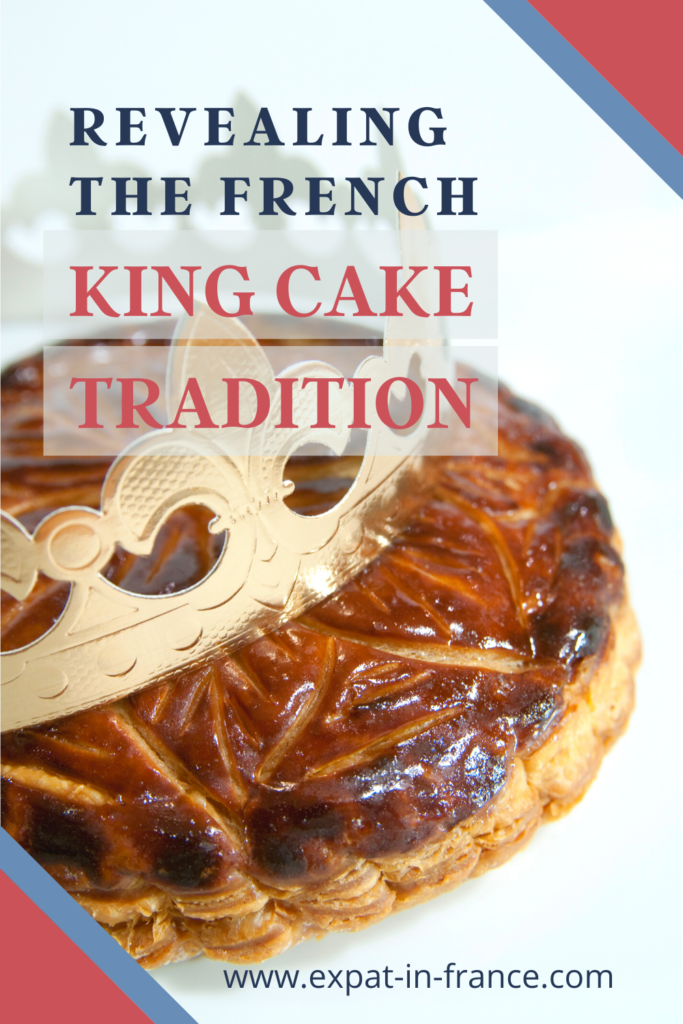Did you know the French go on eating after New Year’s Eve?
The Christmas feast goes on. As soon as January starts, most countries would make a serious cleansing diet or at least have a more balanced and healthy diet. Not the French! Do you know what is a King cake in France?
Let’s dive into this Epiphany tradition in France.
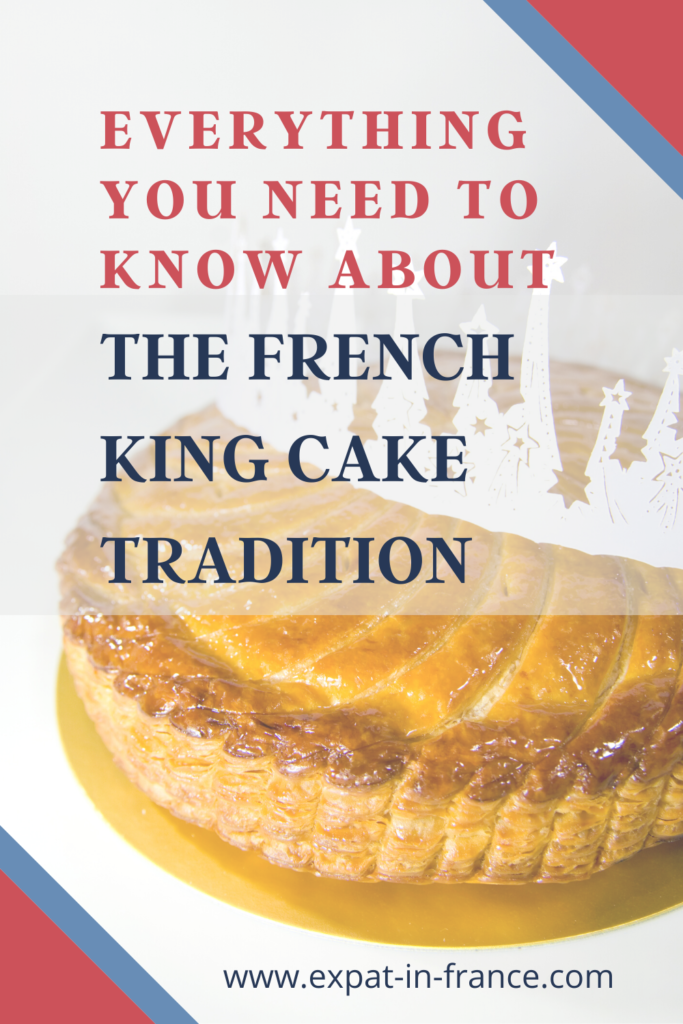
Table of Contents
What is a King cake in France?
The King cake in France is called la Galette des rois. We eat the galette on January 6 but also all along the month of January!
It is made of puff pastry and “frangipane”, an almond, sugar and butter stuffing mixed with french pastry cream. It is just a delight!
In the South of France, the galette is a brioche with candied fruit.
The best is to buy your galette des rois at the bakery rather than the supermarket. If you want to make a home-made galette des Rois, I will give you a recipe below.
I recommend you warm it up in the oven for a few minutes before eating it. It is much better!
It goes perfectly with a glass of fizzy cider or if you prefer a glass of Clairette de Die (French sparkling wine) or even Champagne!
The tradition of the galette des rois in France
What can we find inside a King cake in France?
Traditionally a bean (une fève) was hidden inside the king cake in France.
Nowadays, it is often a small figurine in porcelain or plastic. It is often a character or a cultural icon. Some people even collect these figurines.
La galette des Rois is eaten at home, in public schools, some professional canteens and even at a special reception at the Elysée Palace, the French President residence. There is no lucky charm in the Elysee’s galette since it would be bad taste for the President to be the King.

Who will be the King or the Queen for the day?
The French perpetuate a Roman pagan tradition of picking a King for the day with a bean inside a cake. Even the way it is done nowadays goes back to these ancient times!
The youngest child present hides under the table. He or she will pick who will get the slice that is being served. When everyone is served the child comes back to its chair. Then, everyone can start eating (without looking for the lucky charm or it would be cheating!).
The one having the lucky charm will be the king or queen and will receive a crown! He or she will choose his king or queen for the day.
The bakeries usually sell the King cake in France with one or two cardboard crowns to enable their customers to “tirer les rois” (to draw the kings).
Where does the tradition of the king cake originate?
The Pagan tradition
A very old Roman tradition was making a slave the king for the day. The King was also chosen thanks to a bean in a cake! This ancient pagan tradition travelled in times to the Middle age.
Like most ancient traditions we still celebrate today, it has been integrated into the Christian calendar and traditions.
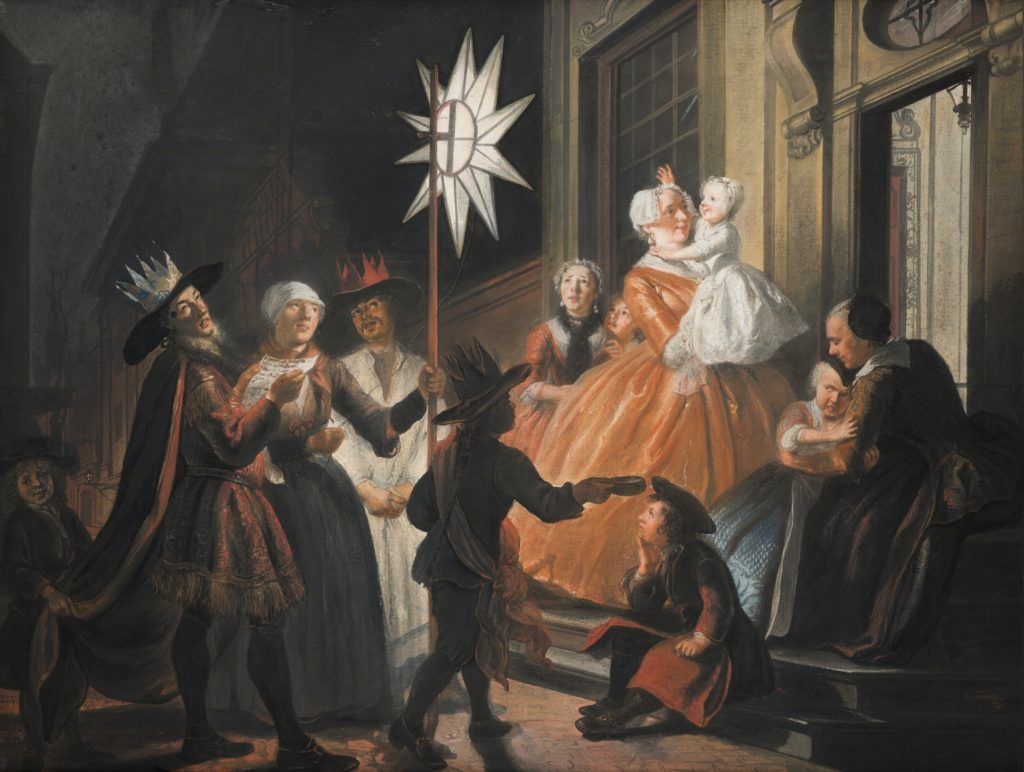
The Christian tradition: The Epiphany
There are many myths and beliefs around the world about the 12 days between Christmas Day and the Epiphany on January 6 as per the Christian calendar.
In the Middle Ages, la fête des Fous (The feast of Fools) was a wildly popular party. On January 6, until the 16th Century, the mob was picking a young cleric to be a Pope for one day. This fool’s king was in charge of giving the blessing to the crowd on Epiphany day.
Victor Hugo actually started his famous novel Notre-Dame de Paris (The Hunchback of Notre Dame.) with the Fête des Fous.
In France, the tradition of the King cake has mainly been secularised compared to other European countries such as Spain where the Epiphany is even more celebrated than Christmas.
Of course, some people in France still celebrate January 6 as a Christian celebration: the Epiphany.
However, January 6 is not a bank holiday in France as is the case in Spain for example.
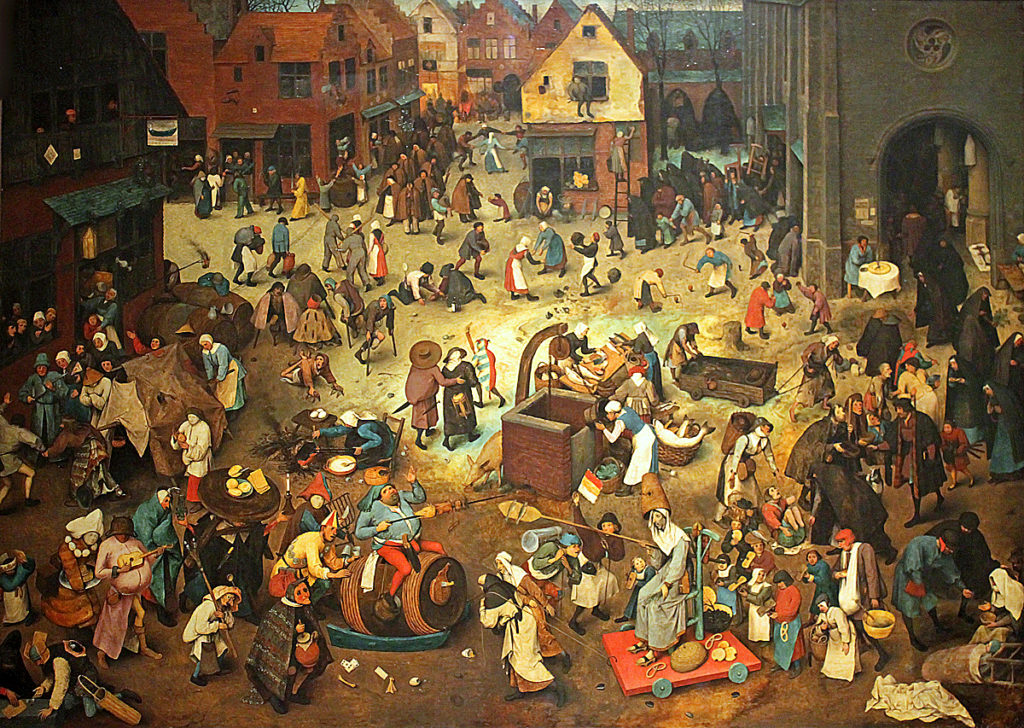
Where in the world can you eat king cake?
A few countries kept this ancient tradition of the Twelfth Night cakes or the King cake until nowadays. They are mainly Christian countries.
You will find the Roscón de Reyes in Spain or the Portuguese bolo rei and the South of France Brioche des rois. The Rosca de reyes is eaten in most Latino-American countries.
Eastern Europe, the Balkans and Greece also have a similar tradition with the vassilopita.
King Cake in France: Galette des Rois recipe
You can choose to make a home-made Epiphany cake.
The galette des rois is actually quite easy to make (if you buy the puff pastry already made).
TIP: the best recipes have several waiting times but if you are in a rush, you can skip these. It might not be as good but it is still worth doing it home-made.
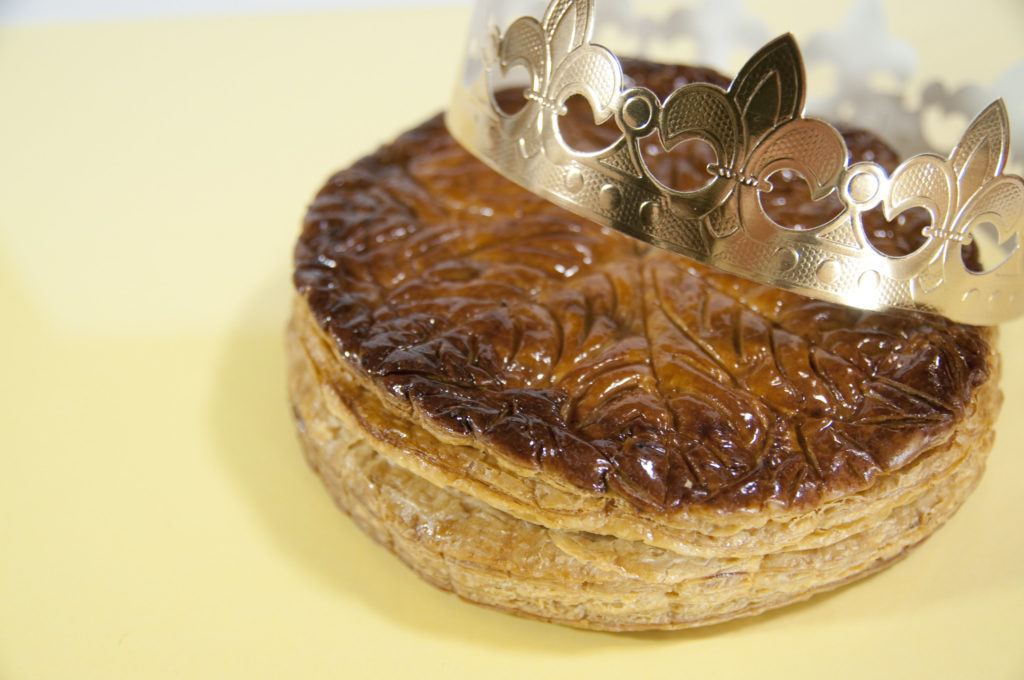
Ingredients
French pastry cream (Crème pâtissière)
- 125g skimmed milk
- 1 egg yolk
- 15g caster sugar
- 15g wheat flour T45
- ½ vanilla pod
Almond cream (Crème d’amande)
- 100g icing sugar
- 160g ground almonds
- 100g slightly salted butter (beurre demi-sel)
- 1 teaspoon of rum (optional)
- 2 eggs
- 20g wheat flour T45
Gilding
- 1 egg yolk
- 2 g liquid cream
- 1 pinch of fleur de sel (French sea salt)
Cut the salted butter into small cubes and let it soften at room temperature.
How to make the French pastry cream
Bring the milk to a boil with the vanilla pod cut in length. In a bowl, whisk the egg, the caster sugar and the flour until getting a creamy mix.
Then, add the hot milk and keep wishing. Transfer the pastry cream to a saucepan. Whisk without stopping on high fire to thicken the cream. Take out of the fire as soon as it has thickened. Continue to whisk until getting a smooth cream. Keep the cream in a bowl.
How to make the almond cream
In a bowl, mix the butter cubes with a fork, add the eggs, the icing sugar, the ground almonds, the flour and the rhum (if applicable) until getting a smooth filling.
Mix the almond cream with the French pastry cream slowly not to incorporate too many air bubbles into the filling.
Cover the filling with a film and keep it for one-hour minimum in the fridge.
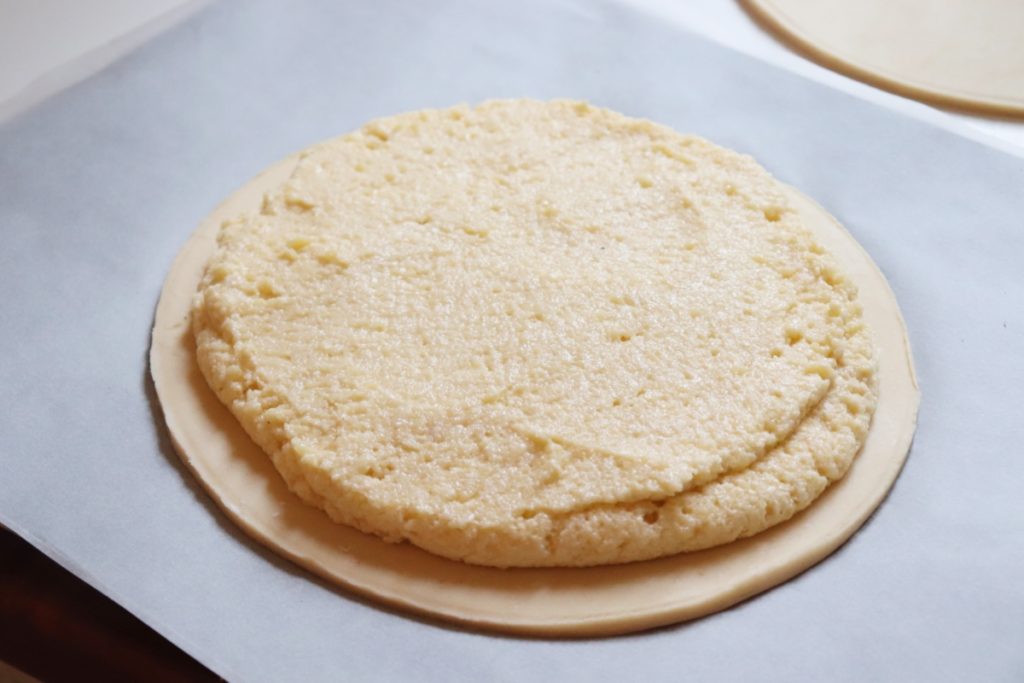
Assemble the Galette des rois
Put together the king cake
Since I am making a galette with already prepared puff pastry, the king cake assembly is simpler. If you also make this choice, make sure you choose a dough with pure butter as many are made with vegetal oils.
You can choose to make a home-made puff pastry. It is now made much easier with a stand mixer.
Put the rolled-out dough on kitchen paper on your oven tray. Spread carefully the filling on the pastry 3 cm of border bare. Wet the edge with water without touching the filling.
Put the lucky charm into the filling nearer to the edge.
Put the second dough over the filling by ejecting the air. Press the borders slightly. If some filling escapes, clean the edges and press again.
Using the back of a knife, scallop the edges by pushing into the dough (about 1 cm deep).
Gilding
Mix the yolk, the cream and the salt. Brush a thin layer of the mix over the top of the galette apart from the borders (otherwise the puff pastry won’t lift).
With the point of a knife, etch a design into the top of the galette carefully, not to pierce the dough. Cut 6 small slits in the top as steam vents.
Refrigerate again for two hours.
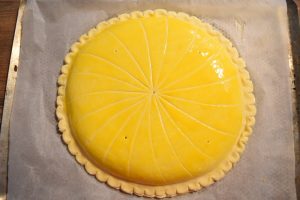
Baking
Heat the oven to 180°c. Put in the oven at mid-level for 35 minutes. The king cake should be puffed and golden.
Transfer to a rack, and cool for at least 10 minutes (the galette des rois may deflate). Serve lukewarm or at room temperature.
Bon appétit
The galette des Rois is usually eaten all along January. Make the most of eating, before February and the unofficial French Crepe Day!
Joyeuse fête des rois!
Liked this post? Pin it for later!
